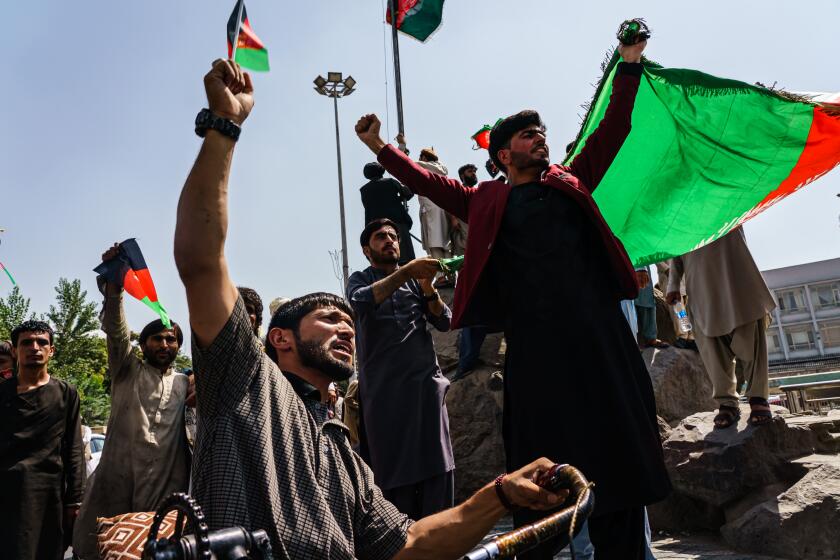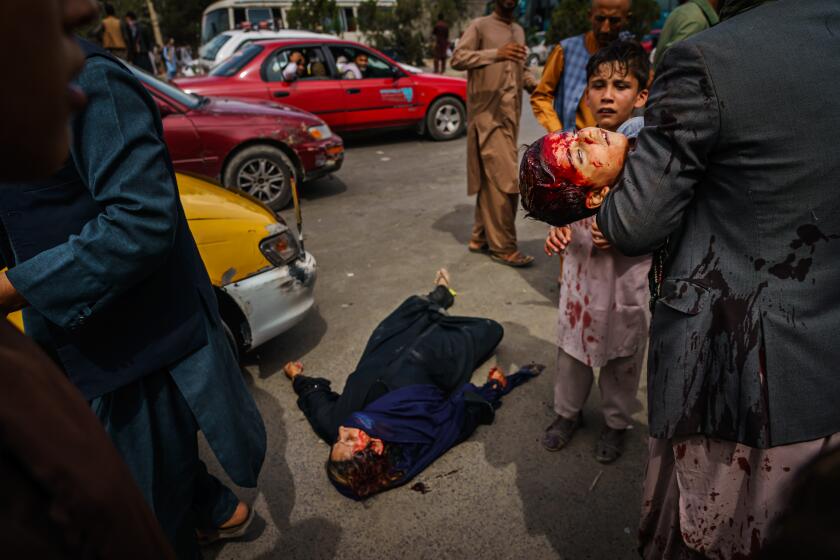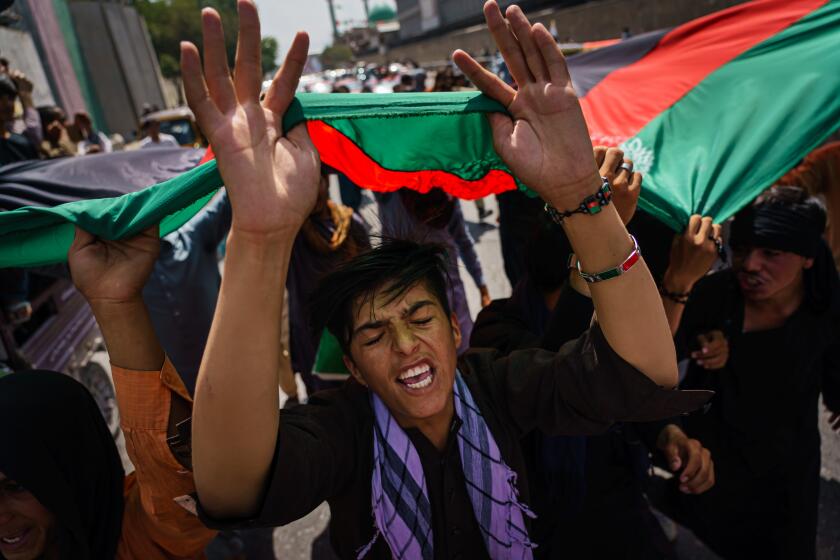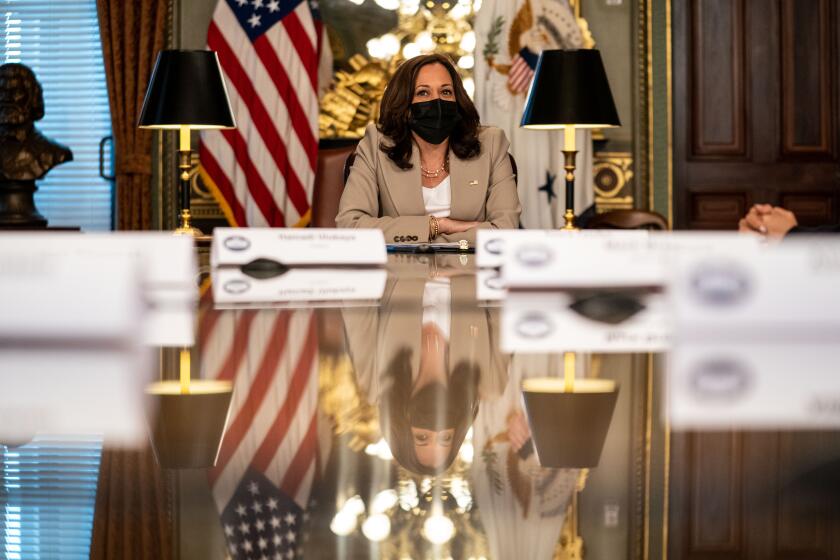Afghans protest Taliban rule as group boasts of beating ‘arrogant’ U.S.
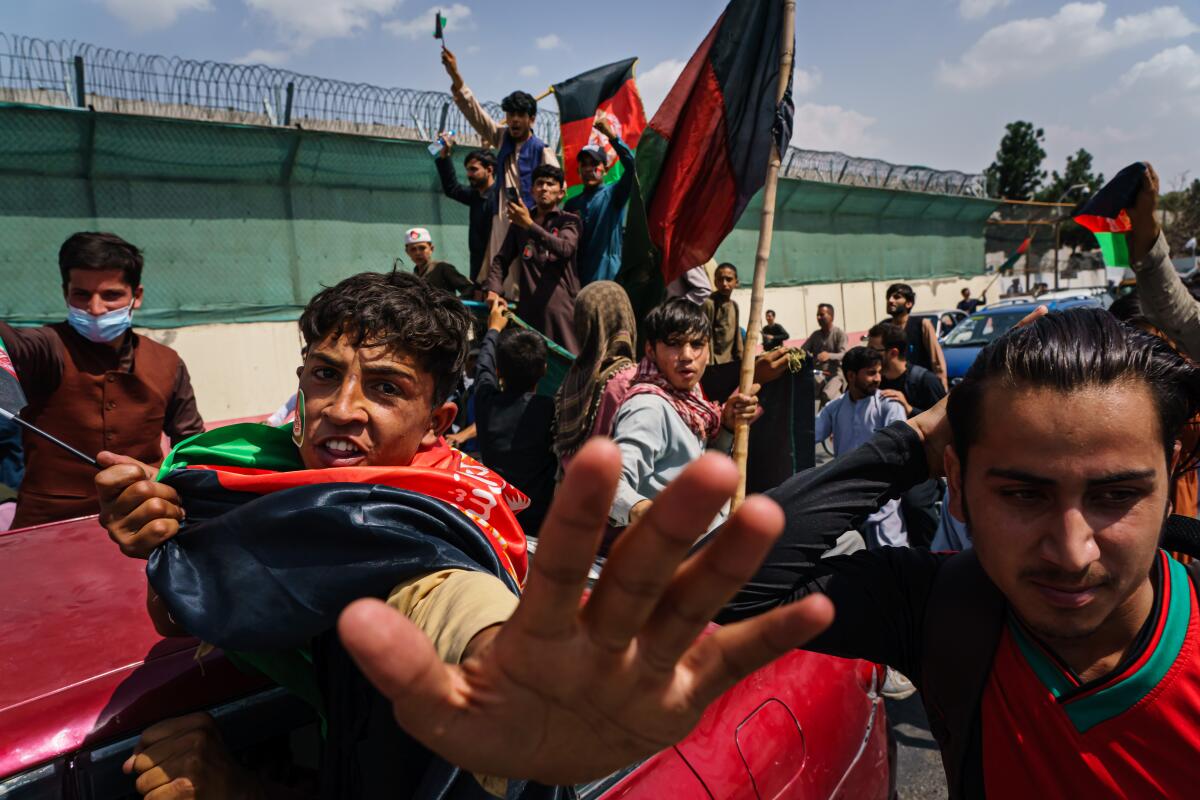
- Share via
KABUL, Afghanistan — Anti-Taliban protesters defied their new rulers for a second day Thursday, marking Afghanistan’s independence day by attempting to hoist the red, green and black national banner but often getting beaten down by militant fighters who control the streets of the capital and elsewhere.
The jarring, violent scenes marked the latest unrest as the Taliban sought to gain a firmer grip on a nation that has changed much since it first ruled two decades ago. That was proving increasingly difficult, even as the militant group sought to compare Afghanistan’s independence from Britain in 1919 to the insurgents’ swift takeover of the country this week from an American-backed government.
The Taliban said in a statement that its “jihadi resistance forced another arrogant power of the world, the United States, to fail and retreat from our holy territory of Afghanistan.”
But anger against the group was rising, and governing was proving perilous.
A gridlock crush at the international airport in Kabul, meanwhile, surged again, with desperate Afghans and others attempting to flee abroad. In Washington, the Pentagon said that since July it had flown 12,000 people out of the airport in the capital, including American diplomats, Afghans eligible for special visas because of their work on behalf of the U.S. military and diplomatic missions, and others.
Only about 2,000 were airlifted out of Kabul in a dozen military flights in the last 24 hours, State Department spokesman Ned Price said in a Thursday briefing. An additional 6,000 evacuees were processed and awaiting departure at the airport Thursday evening, he said.
Still, the numbers fell far short of the 9,000 people a day that the Pentagon says it has the capacity to evacuate. The shortfall highlights both the slow bureaucratic process to finish paperwork for Afghans needing to leave and the terrifying difficulty many Americans and others are confronting as they attempt to make their way to the airport for evacuation flights.
Price repeatedly attempted to turn aside persistent questions from reporters citing numerous accounts of Americans and especially Afghans unable to navigate past the gantlet of Taliban checkpoints to reach the airport.
He said all U.S. citizens who have “expressed interest in leaving” Afghanistan were contacted by American diplomatic officials overnight and told to proceed to the airport — even though the U.S. government has said it cannot guarantee safe passage. Price would not say how many people were involved.
The administration says it reached a “safe passage” agreement with the Taliban, but it seems to apply only spottily. Pentagon spokesman John Kirby also revealed Thursday that U.S. fighter jets are making regular passes over the Kabul airport for protection.
“The U.S. military is undertaking a gargantuan airlift operation right now,” Price said. But he acknowledged, as Defense Secretary Lloyd J. Austin III has said this week, that the estimated 5,000 U.S. forces at the Kabul airport do not have the equipment or strength in numbers to venture outside the airport and into the city to retrieve Americans or Afghans eligible to leave. There are reports that British special forces have launched such rescue missions.
The reality on the ground, with protracted, torturous attempts to enter the airport, contradicted statements at the State Department and Pentagon.
Near the Kabul airport, lines of cars parked alongside concrete blast walls sat empty after families abandoned them to attempt to cross the perimeter on foot. The crowds lugged large suitcases and wore their best clothes and shoes. Siblings held hands and parents carried sleeping children.
With the Taliban in control in Afghanistan’s capital and the Biden administration under fire for a chaotic withdrawal, a look at what went wrong.
But the masses on the narrow road into the airport came to a standstill, where Afghans had to wait behind the first Taliban checkpoint. A skinny Taliban fighter with neck-length hair stood on an elevated platform, wearing a laxly affixed surgical mask for COVID-19 prevention, and a semiautomatic pistol and a walkie-talkie radio on his left side, as he shouted orders.
The morose crowd continued to grow, trying to make its escape, which lay behind the Taliban fighter, past concrete walls, guard towers and barbed-wire fencing.
Salman, 30 and his wife, Sana, 25, walked toward the gate holding hands, a rare sight in Afghanistan. They didn’t want their last names used. They both possessed exit papers for the United States. Salman worked for the U.S. military, in a budget department, for 13 years and now fears retribution from the Taliban.
When he arrived with his wife at the airport gate, his mother called him, crying. He told his mother on the phone, “I’m now at the gate. Pray for me.”
The Taliban has offered contradicting portrayals of its intentions, claiming to be more moderate than it was during its brutal rule in the 1990s, but also saying it will abide by sharia, or Islamic law. The Taliban interpretation of sharia is among the most draconian in the world. Many fear the group will succeed in erasing two decades of efforts to expand women’s and human rights in Afghanistan and build democratic institutions.
Though it has yet to formally appoint its government, the Taliban is about to confront many of the difficulties of actually governing, given the shortages of cash and supplies. Other countries and global institutions, such as the International Monetary Fund, have warned they would withhold the much-needed foreign aid that has sustained much of Afghanistan’s economy for years.
Taliban fighters lash out at a crowd of hundreds corralled outside Kabul’s airport in a tumultuous scene from the U.S. withdrawal and Taliban takeover.
A United Nations official also warned of dire food shortages in a country of 38 million people reliant on imports and where hundreds of thousands have been displaced as the Taliban swept across the country.
“A humanitarian crisis of incredible proportions is unfolding before our eyes,” Mary Ellen McGroarty, the head of the World Food Program in Afghanistan, warned in a statement. Drought, she said, has destroyed more than 40% of the country’s crops.
“This is really Afghanistan’s hour of greatest need, and we urge the international community to stand by the Afghan people at this time,” she said.
With such pressures, the Taliban leadership also appeared keen to quell dissent. Pockets of resistance were emerging across the country, and in Kabul this was most evident in the independence day flag-raising ceremonies.
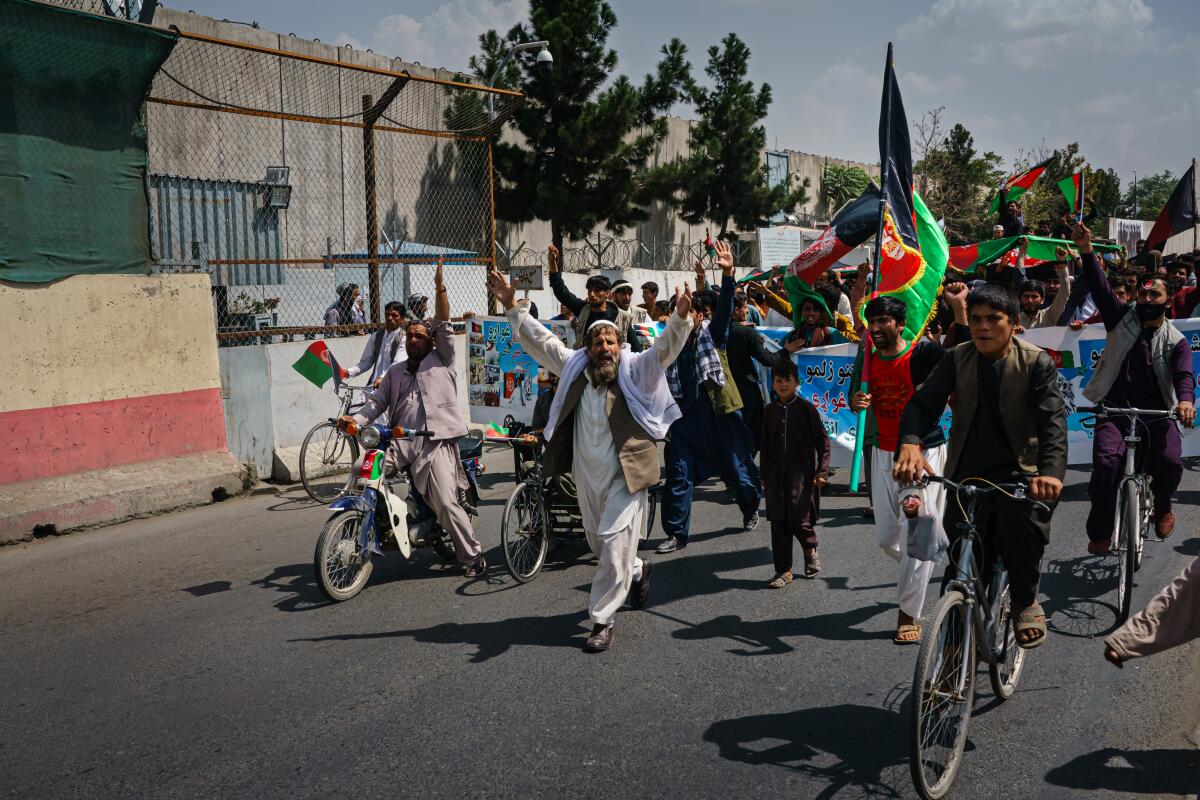
At one traffic circle in central Kabul, Afghans who gathered to raise the national flag to replace the white Taliban banner chanted, “God bless Afghanistan,” and “Long live the flag of Afghanistan.” A group of Taliban fighters approached and pointed their guns at the gathering.
Los Angeles Times photographer Marcus Yam was attempting to photograph the scene when a Taliban fighter emerged and punched him on the side of the head. Militants continued to beat Yam and another photographer working for a major U.S. newspaper. The two were eventually released.
Taliban fighters rough up two journalists, then seek to make amends by offering water and a sports drink.
Taliban authorities also violently broke up a protest in the eastern province of Khost, then instituted a 24-hour curfew Thursday, the Associated Press reported. Afghans also demonstrated in Kunar province, the AP reported, and in the eastern city of Jalalabad, where protesters on Wednesday replaced the Taliban banner with Afghanistan’s flag. At least one person was reported killed.
“I predict that we will start seeing all kinds of resistance, some of it will be peaceful, some of it will be violent,” Candace Rondeaux, former advisor to the Office of the Special Inspector General for Afghanistan Reconstruction, a government watchdog agency, said in a teleconference Thursday sponsored by the New America think tank.
In Kabul, artist Basira Shahnawaz, 25, was watching the protests Thursday. “People protest that they do not accept the Taliban,” she said via WhatsApp. “In the streets, they raise the Afghan flag and chant slogans.”
Shahnawaz was hiding at her home, which is filled with paintings and sculptures, amid reports that Taliban militants are conducting door-to-door searches. As soon as the fighters enter, they will know she’s an artist and probably target her, she said, recalling the past rule of the Taliban.
“They kill artists,” she said.
The vice president says she was the last person in the room to advise President Biden when he decided earlier this year to pull out from Afghanistan.
President Biden said he was committed to keeping U.S. forces in Afghanistan until every American is evacuated, even if that means maintaining a military presence there beyond his Aug. 31 deadline for withdrawal. In an interview with ABC’s “Good Morning America” that aired Thursday, Biden said he didn’t believe the Taliban had changed.
“I think they’re going through sort of an existential crisis about ‘do they want to be recognized by the international community as being a legitimate government,’” Biden said. “I’m not sure they do.”
Yam reported from Kabul and Wilkinson from Washington. Times staff writer Molly Hennessy-Fiske in Houston contributed to this report.
More to Read
Sign up for Essential California
The most important California stories and recommendations in your inbox every morning.
You may occasionally receive promotional content from the Los Angeles Times.
